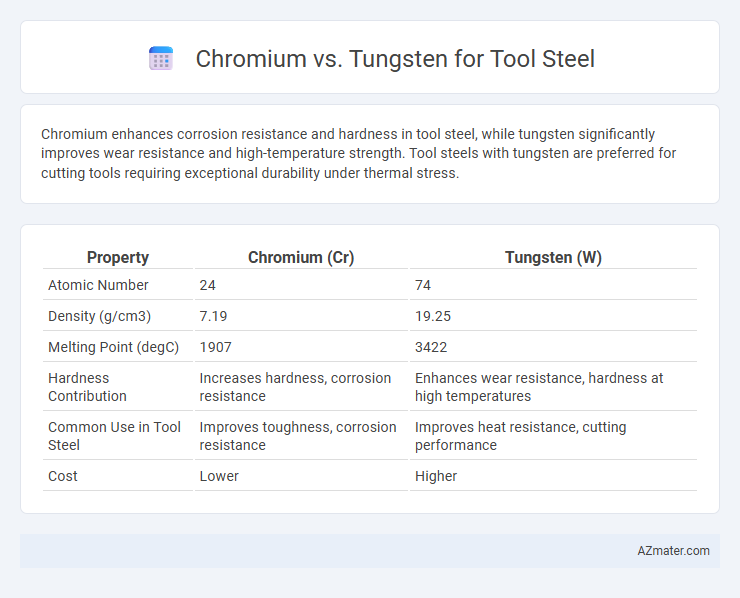Chromium enhances corrosion resistance and hardness in tool steel, while tungsten significantly improves wear resistance and high-temperature strength. Tool steels with tungsten are preferred for cutting tools requiring exceptional durability under thermal stress.
Table of Comparison
| Property | Chromium (Cr) | Tungsten (W) |
|---|---|---|
| Atomic Number | 24 | 74 |
| Density (g/cm3) | 7.19 | 19.25 |
| Melting Point (degC) | 1907 | 3422 |
| Hardness Contribution | Increases hardness, corrosion resistance | Enhances wear resistance, hardness at high temperatures |
| Common Use in Tool Steel | Improves toughness, corrosion resistance | Improves heat resistance, cutting performance |
| Cost | Lower | Higher |
Introduction to Chromium and Tungsten in Tool Steels
Chromium and tungsten are essential alloying elements in tool steels, each enhancing specific properties for industrial applications. Chromium improves hardness, corrosion resistance, and wear resistance by forming stable carbides, while tungsten significantly increases high-temperature strength and toughness through its influence on grain refinement and carbide formation. These elements play a critical role in optimizing tool steel performance for cutting, forming, and machining operations.
Chemical Properties: Chromium vs Tungsten
Chromium in tool steel enhances hardness, corrosion resistance, and oxidation resistance through the formation of stable carbides and chromium oxide layers. Tungsten increases hot hardness and wear resistance by creating hard tungsten carbides that maintain strength at elevated temperatures. The combined presence of chromium and tungsten in tool steel results in a balanced chemical composition that improves durability and performance under extreme conditions.
Influence on Hardness and Wear Resistance
Chromium significantly enhances tool steel hardness by promoting the formation of hard carbides, improving wear resistance and edge retention during heavy-duty applications. Tungsten increases hardness through the development of stable tungsten carbides, which provide exceptional high-temperature strength and abrasion resistance in cutting tools. The combination of chromium and tungsten in tool steel results in a balanced microstructure that maximizes hardness and wear resistance, extending tool life in demanding industrial environments.
Impact on Toughness and Ductility
Chromium enhances toughness and ductility in tool steels by forming hard carbides that improve wear resistance without significantly reducing impact strength. Tungsten increases hardness and high-temperature strength through stable carbide formation but can reduce toughness due to carbide brittleness. Balancing chromium content supports improved ductility, while high tungsten levels prioritize hardness at the expense of impact resistance.
Heat Treatment Response and Stability
Chromium enhances tool steel's hardenability and corrosion resistance, improving heat treatment response by promoting uniform hardness and reducing distortion during quenching. Tungsten contributes to secondary hardness retention at high temperatures, increasing thermal stability and wear resistance in cutting applications. Balancing chromium and tungsten optimizes steel performance, combining improved heat treatment stability with superior hardness retention under thermal cycling.
Corrosion Resistance Comparison
Chromium significantly enhances tool steel's corrosion resistance by forming a stable, passive oxide layer that protects against rust and chemical degradation. Tungsten primarily improves hardness and high-temperature strength but offers limited benefits for corrosion resistance in tool steels. High-chromium tool steels, such as those containing 12-20% chromium, exhibit superior resistance to oxidation and acidic environments compared to tungsten-alloyed variants.
Cost and Availability in Tool Steel Production
Chromium is more cost-effective and widely available than tungsten in tool steel production, making it the preferred alloying element for enhancing hardness and corrosion resistance while managing expenses. Tungsten's higher cost and limited availability stem from its complex extraction processes and global supply constraints, which can increase production costs for tool steels requiring extreme heat resistance and wear properties. Manufacturers often balance chromium's affordability and tungsten's superior performance by optimizing alloy compositions according to application-specific requirements and economic factors.
Typical Applications in Industry
Chromium-enhanced tool steels are commonly used in applications requiring high hardness, wear resistance, and corrosion resistance, such as cutting tools, molds, and dies in automotive and aerospace industries. Tungsten tool steels offer superior red hardness and thermal stability, making them ideal for high-speed cutting tools, drills, and milling cutters used in metalworking and heavy machinery manufacturing. Both elements improve toughness and durability, but chromium's corrosion resistance is preferred in environments exposed to oxidation, while tungsten excels in high-temperature cutting operations.
Environmental and Health Considerations
Chromium in tool steel offers corrosion resistance but poses environmental risks due to hexavalent chromium compounds, which are toxic and carcinogenic during manufacturing and disposal. Tungsten is less toxic and has lower environmental impact, although mining and refining processes still require careful management to prevent habitat disruption and pollution. Selecting tool steel with tungsten reduces hazardous emissions and health risks associated with airborne chromium particles.
Choosing the Right Alloying Element for Tool Steel
Chromium enhances tool steel by boosting hardness, corrosion resistance, and wear resistance, making it ideal for applications requiring durability and oxidation protection. Tungsten significantly increases high-temperature strength and hot hardness, essential for cutting tools subjected to intense heat and stress. Selecting between chromium and tungsten depends on the required balance between corrosion resistance and thermal stability for specific tooling demands.

Infographic: Chromium vs Tungsten for Tool Steel
 azmater.com
azmater.com